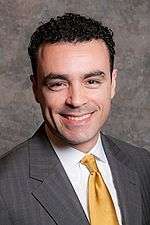Miguel Roman
| Miguel Román | |
|---|---|
 | |
| Born | San Juan, Puerto Rico |
| Nationality | Puerto Rican/American |
| Alma mater |
University of Puerto Rico Cornell University Boston University |
| Occupation | NASA Scientist |
Miguel Román, is a research physical scientist with the National Aeronautics and Space Administration (NASA). He is the recipient of the Presidential Early Career Award for Scientists and Engineers (PECASE) award, the highest honor bestowed by the United States government on scientists and engineers beginning their independent careers.
A major focus of Román's work is the quantification of uncertainty in long-term satellite measurements of the Earth's surface at both moderate and high spatial resolutions. Román has developed a combination of global quality assessment and validation techniques that include visible, near-infrared, and multi-angular imagery and measurements acquired from in-situ and semi-autonomous airborne platforms.[1] His efforts to improve narrowband reflectance anisotropy models to estimate the Bidirectional Reflectance Distribution Function (BRDF) of land surfaces have led to major advancements in the estimation of terrestrial essential climate variables routinely used to monitor human activity patterns and natural disturbances from satellite platforms. As a lead member of the Moderate Resolution Imaging Spectroradiometer (MODIS) and Visible Infrared Imaging Radiometer Suite (VIIRS) Land Discipline teams, Román's research has enabled scientists to quantify how much of the variations in satellite observations are due to sensor performance, terrain, and/or geometry (view angle) effects; a critical factor when satellite measurements are used to drive policy related to global change. Most recently, Dr. Román’s research has focused on examining global variations in energy service demand using data from the VIIRS Day-Night Band (DNB) on board Suomi-NPP.[2]
Early years
Miguel Román was born in San Juan, Puerto Rico. After he graduated from CROEM high school, he attended the University of Puerto Rico, Mayagüez Campus and, in 2004, earned a Bachelor of Science degree in Electrical Engineering. Román continued his academic studies at Cornell University, earning a Master's degree in Systems Engineering (2005). In 2009, he received a doctorate in Remote Sensing from Boston University. While studying at BU, Román did his dissertation research at NASA's Goddard Space Flight Center in Maryland, as part of NASA's Harriett G. Jenkins Fellowship and the Graduate Student Research Programs.
Career at NASA
Upon his graduation from BU, Román became a research physical scientist in the Terrestrial Information Systems Laboratory at NASA Goddard Space Flight Center (GSFC).[3] Currently, Román leads the Land Product Validation (LPV) activities surrounding the EOS Terra/Aqua MODIS and Suomi-NPP VIIRS instruments, as well as field-based and airborne experiments using small-UAS platforms. He is also the principal NASA scientist for the Visible Infrared Imaging Radiometer Suite (VIIRS) Day/Night Band on Suomi-NPP. At the agency level, Román also serves on NASA's Center Disaster Working Group in the role of representative to the MODIS/VIIRS science teams, and as NASA/GSFC's point of contact for disaster-related information and response awareness. At the international level, Román serves as the current chair of the Land Product Validation Subgroup on the Committee on Earth Observation Satellites (CEOS) Working Group on Calibration and Validation (WGCV).[4]
Román has been recognized for his speaking engagements at conferences and media interviews. His recent research work using the VIIRS instrument on Suomi-NPP has received international attention in more than 100 outlets; including CNN,[5] The Washington Post,[6] The Wall Street Journal,[7] and NPR.[8] He has authored or co-authored over 30 papers in major remote sensing journals and is credited with over 1000 citations over the last 5 years.[9] Román is the recipient of NASA’s Early Career Achievement Medal (2012), the IEEE Geoscience and Remote Sensing Society Graduate of the Last Decade (GOLD) Award (2012), was an honoree for the Samuel J. Heyman Service to America Medals “Call to Service” award;[10] and, in 2017, became a recipient of the Presidential Early Career Award for Scientists and Engineers (PECASE) award, the highest honor bestowed by the United States government on scientists and engineers beginning their independent careers.
|
|
See also
- List of Puerto Ricans in the United States Space Program
- List of Puerto Rican Scientists and Inventors
References
- ↑ "MALIBU Field Campaign at Pawnee National Grasslands, Colorado". NASA. Retrieved 14 July 2016.
- ↑ "Satellite Sees Holiday Lights Brighten Cities". NASA. Retrieved 14 July 2016.
- ↑ "GSFC Profile for Miguel Román - Hydrospheric and Biospheric Sciences Research (610HB) - Terrestrial Information Systems Laboratory (619)". NASA. Retrieved 5 January 2011.
- ↑ "CEOS WGCV LPV Website". NASA. Retrieved 14 July 2016.
- ↑ "nasa-holiday-lights-from-space". CNN. Retrieved 14 July 2016.
- ↑ "nasa-scientist-takes-measure-of-earth". Washington Post. Retrieved 14 July 2016.
- ↑ "nasa-holiday-lights-from-space". WSJ.com. Retrieved 14 July 2016.
- ↑ "night_watch_washington_from_space". NPR. Retrieved 14 July 2016.
- ↑ "Miguel Román -- Google Scholar Citation Record". Google Scholar. Retrieved 14 July 2016.
- ↑ "Miguel O. Román - Samuel J. Heyman Service to America Medals". Servicetoamericamedals.org. Retrieved 14 July 2016.
External links
- Miguel Roman. Hydrospheric and Biospheric Sciences Research (614) - Terrestrial Information Systems Laboratory (619), NASA. Retrieved 2011-01-07.